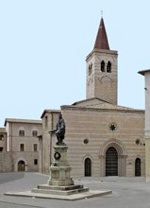
In his life of St Vincent (whom he identified as one of the 300 Syrian monks who came to Italy in the 6th century), Ludovico Jacobili (referenced below, at p. 147) had St Vincent install St Florentius as a monk at San Salvatore, the monastery he had established at Foligno. Despite the frailty of the hagiographic sources, this might have some basis in fact: according to Paola Guerrini and Francesca Latini (referenced below, at p. 139):
-
“... the dedication of this church as San Salvatore, its monastic character and its suburban location all suggest ancient origins. ... [The examples of] the churches dedicated as San Salvatore in Spoleto, Terni, Narni, Calvi and Otricoli suggest a link to the Lombard presence in the territory” (my translation)
They proposed (at p. 301, entry 78) a date in the late 6th century. (Duke Faroald I established the Lombard Duchy of Spoleto in ca. 575 AD).
San Salvatore was first documented as a monastery (“monasterio quoque sancti Salvatoris”) in 1138, when Pope Innocent II confirmed it as a possession of the Bishop Benedetto of Foligno. Paola Guerrini and Francesca Latini (referenced below, at p. 93 and note 373) described a document in the archives of the Abbazia di Sassovivo dated 1217 in which San Salvatore was ‘extra murum civitatis’: it is likely that it was just outside the Porta Antica della Badia.
The monastery was subsequently demolished, and San Salvatore became a parish church and was listed in the “sentenza” of Cardinal Ranieri Capocci as a possession of the diocese. The church had close connections with the Trinci family:
-
✴Corradino di Rinalduccio Trinci, who was prior of San Salvatore in 1338-83, was buried here.
-
✴Rinaldo Trinci, the son of Corrado Trinci, was prior of San Salvatore in 1430-9. The canons also elected him as Bishop of Foligno in 1437, although this was not recognised by Pope Eugenius IV. After the fall of Foligno in 1439, Rinaldo was forced into exile.
By the 15th century, it had achieved the status of a collegiata, serving the Terziero Superiore.
Exterior
The red and white marble façade of the church and its three portals probably date to the 14th century, but the rose windows above were rebuilt during a major restoration by Vincenzo Benvenuti in 1889.
Interior
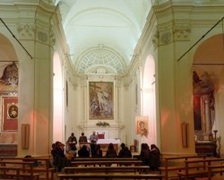
The interior was remodelled by Pietro di Domenico Loni in 1747-59.
High Altar
Francesco Mancini designed the high altar (1754).
Risen Christ (1757)
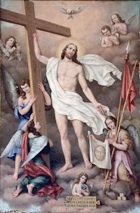
Altare di San Francesco di Paola (1744)
This altar was built at the head of the right aisle shortly before the remodelling of the interior of the church.
St Francis of Paola (ca. 1744)
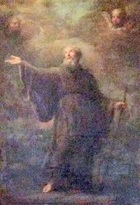
Cappella della Pietà (1751)
Luigi Vanvitelli designed this chapel in the left aisle, which belonged to the Onofrio family.
Pietà (1755)
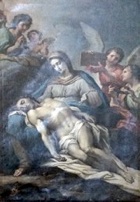
Cappella di San Stanislao Kostka (1756)
This chapel in the right aisle was dedicated to the Polish Jesuit, St Stanislaus Kostka, who had been canonised in 1726.
Madonna and Child with St Stanislaus Kostka (1756)
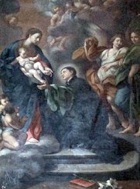
Other Art in the Church
Crucifix (14th century)
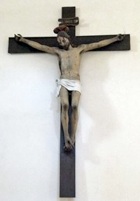
Fresco Fragments (14th century ?)
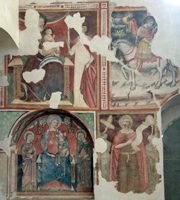
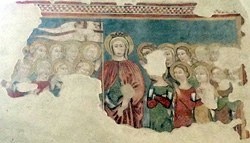
These surviving elements of the original decoration of the counter-façade include:
-
✴four frescoes to the left of the entrance;
-
•the Madonna and Child enthroned, with St Catherine of Alexandria;
-
•St Martin sharing his cloak with a poor man;
-
•the Madonna del Latte with two female saints, in a fictive niche; and
-
•St John the Baptist; and
-
✴the upper part of a fresco of [St Ursula and the 10,ooo martyrs ??] to the right of the entrance.
Risen Christ (16th century)
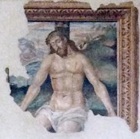
Art from the Church
Tomb of Corradino di Rinalduccio Trinci (14th century)
This tomb was moved from the centre of the church to the sacristy, presumably when the facade was restored in 1889. [Where is it now?]
San Salvatore Polyptych (1432)
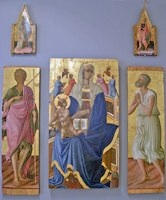

Detail of main panel
Rinaldo Trinci, who became prior of San Salvator in 1430, commissioned this documented polyptych for the high altar of San Salvatore from Bartolomeo di Tommaso. It was moved to the Altare dei SS Simone e Guida in 1662.
The panels that remain in Foligno (illustrated above) are now in the Museo Diocesano.
-
✴The central panel depicts the Madonna and Child enthroned, with a tiny figure of the kneeling Prior Trinci (bottom right, illustrated above).
-
✴The panels to the sides depict St John the Baptist and the Blessed Peter Crisci.
-
✴The panels from the top register exhibited in the museum depict SS Bartholomew and Ursula.
Four other panels were sold in 1825.
-
✴One of them, which was the central panel in the top register, has been lost.
-
✴The other three, which formed the predella, have been identified as:
-
•Christ’s agony at Gethsemane, in the Pinacoteca Vaticana, Rome;
-
•the road to Calvary, in the Musée du Petit Palais, Avignon; and
Flight into Egypt (ca. 1432)
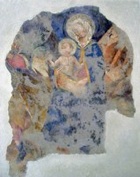
Palazzo dei Canonici di San Salvatore (ca. 1300)
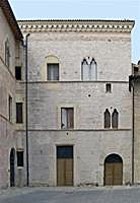
Read more:
P. Guerrini and F. Latini, “Foligno: Dal Municipium Romano alla Civitas Medievale: Archeologia e Storia di una Città Umbra”, (2012) Spoleto
L. Jacobili, “Vite de' Santi e Beati di Foligno”, (1628)
Return to the page on Monuments of Foligno.
Return to Walk I.




